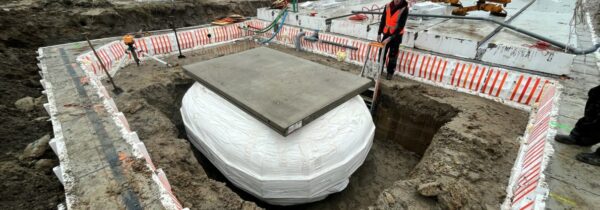EPS energy storage tank under the driveway
Great news, Royal Hordijk has recently entered into an exciting partnership with innovative start-up Borg Energy. The energy storage system developed by Borg Energy is revolutionary and will change the way we use and store energy in the Netherlands.
Commercial Director Wiggeman Roodzant explains why this collaboration is so promising: “Borg Energy is a start-up company that has developed a pioneering system: the Borg Smart Heat Battery. This is a large water tank that is buried in gardens or driveways. They are made of EPS (expanded polystyrene). Not only is it a sustainable product, it also has excellent insulating properties.
Energy tariff differences
The system allows people to heat their water when energy costs are low and then use that energy when costs are high. Wiggeman explains: “The system takes advantage of large differences in energy tariffs. As a result, homeowners and businesses save money while reducing their carbon footprint.
Extensively tested at The Green Village
This innovative system has been extensively tested in TU’s The Green Village neighbourhood, where there is an experimental block of housing, including an accurate replica of a 1970s house. The system has been thoroughly tested for over a year, and the results have been so promising that it is ready to be implemented on a larger scale.
Wiggeman points out that Hordijk was actively involved in the design of the EPS buffer used in the system: “The EPS buffer consists of four segments that are glued together in an industrial hall and then sealed with foil. Meta control technology ensures that the entire buffer works optimally. The principle is simple: the more mass, the better the heat retention”.
Developing proactively
Wiggeman emphasises the importance of close cooperation: “Borg Energy chose Hordijk EPS because we actively think and develop with them. Our collaboration has been pleasant and valuable right from the start. We want to make the EPS buffer as good as possible, and that can only be done in partnership. We have talked a lot about how the insulation should work and how we can keep it manufacturable and affordable.
What makes this system so sustainable is that it uses energy costs at the right time by storing energy in EPS tanks. These tanks are also recyclable. EPS already has a low environmental footprint and high insulation value, making it an ideal choice for this sustainable application. Wiggeman added: “This project reflects the role we like to play in projects – we think proactively in developing sustainable solutions.
Looking to the future
Special moulds have been made for the system and production is expected to be scaled up by the end of the year. For now, the focus is on the Dutch market. The system can be purchased privately or collectively and installed on a house-by-house basis.
Wiggeman is optimistic: “Our goal is to continue this cooperation and to look together for ways to improve the system. We strongly believe in sustainable applications and good cooperation, and that is exactly what we have here. The TU district The Green Village, right across the street, is living proof of what is possible with innovative solutions and strong partnerships.

